The Great Wave Off Kanagawa: Surfing Culture's Icon
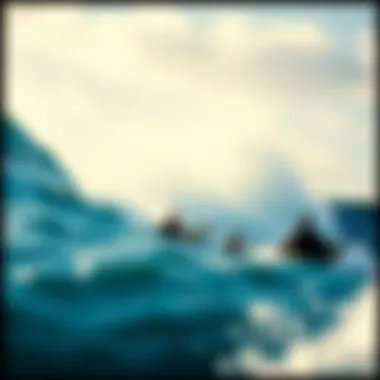
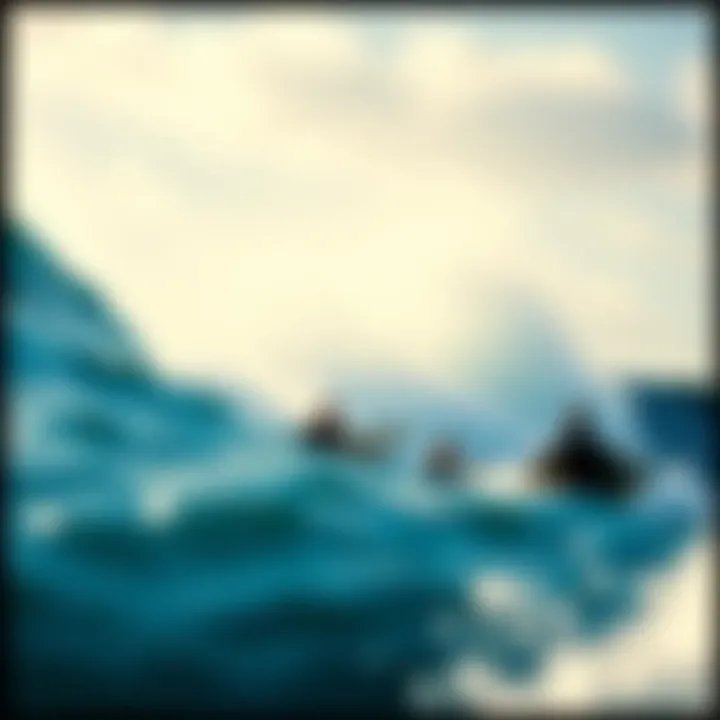
Intro
The Great Wave Off Kanagawa, a woodblock print created by the renowned artist Katsushika Hokusai in the early 19th century, stands as a hallmark in both Japanese art and global culture. It’s not just a simple depiction of nature’s fury; it's a compelling narrative that intertwines artistic expression with cultural identity. The majestic wave, poised to crash upon three tiny boats, symbolizes both nature's power and human resilience. Today, this iconic image resonates deeply with surfers, environmentalists, and art enthusiasts alike, transcending the boundaries of time and geography.
As we peel back the layers of this mesmerizing artwork, the essence of surfing culture emerges uniquely intertwined with its aesthetic charm.
Surfing Techniques
Mastering the Basics
To appreciate the link between The Great Wave Off Kanagawa and surfing, one must understand the fundamentals of the sport itself. Surfing isn’t merely about riding the waves; it’s a craft that demands skill, patience, and a mixture of both mental agility and physical strength.
The process begins with mastering basic techniques. Beginners often start with learning to paddle efficiently and standing up on the board. It’s not unlike the careful yet confident strokes depicted in Hokusai's print—each movement must be synchronized with the wave’s rhythm. If you’re new to surfing, getting accustomed to balancing on your board is crucial. This balance—and the bodily intuition it fosters—reflects the harmony in Hokusai's work, where the wave and boats interact in a delicate dance.
Key Components for Beginners:
- Paddling Techniques: Learn to maneuver your board effectively to catch waves.
- Pop-Up Technique: Transitioning from lying down to standing takes practice and timing.
- Wave Selection: Understanding which waves to approach is vital in avoiding wipeouts.
Advanced Maneuvers
Once the basics are in the bag, seasoned surfers often delve into more advanced techniques that can elevate their surfing prowess. Maneuvers such as off-the-lip turns and aerials require a deep understanding of wave dynamics—a reflection of the beauty found in Hokusai’s wave. The way an artist captures the swell and breaks relates somewhat to a surfer's ability to position themselves for optimal riding.
Advanced Techniques to Consider:
- Bottom Turns: The initial turn at the base of the wave sets up for bigger maneuvers.
- Cutbacks: Sharpen your turns to maneuver back toward the pocket of the wave.
- Aerials: Taking to the air requires speed, agility, and of course, understanding the wave’s shape.
Surfing Lifestyle
Sustainable Surfing Practices
Surf and earth, they go hand in hand. The environmental implications of surfing are profound, and with Hokusai’s wave as a backdrop, it's vital for surfers today to embrace sustainable practices. The ocean, as represented in the artwork, is both a treasure and a resource needing protection. Consider adopting practices like using eco-friendly surfboards, reducing plastic waste, and participating in local beach clean-ups. These simple actions echo the respect for nature that reigned in the era of Hokusai.
Surf Culture Around the World
Surfing culture is as diverse as the waves themselves. It varies globally, taking on unique forms in places like Hawaii, California, and Indonesia. The influence of The Great Wave Off Kanagawa can also be observed in the art of surfboards, fashion, and branding in the surfing community. The wave’s portrayal has not only inspired artists but also serves as a motif for surf culture that champions creativity and freedom. Surfers—often seen as modern-day artists—ride waves with an artistic flair reminiscent of Hokusai’s brushstrokes.
"Art is never finished, only abandoned." – Leonardo da Vinci
This quote rings true in both surfing and art. Just as Hokusai continued to evolve his style, surfers refine their techniques, creating endless possibilities on each wave they ride.
Through a deeper understanding of The Great Wave Off Kanagawa, one can appreciate the fluid relationship between art and surfing. This artwork isn't just an image frozen in time; it has evolved into an enduring symbol, bridging the gap between art lovers and surfing enthusiasts. So next time you’re out on the water, take a moment to appreciate the waves beneath you—and perhaps the artistry of Hokusai that brought them to life.
For more insight into this fascinating confluence of art and surfing, check out Wikipedia on The Great Wave Off Kanagawa or explore the community on Reddit's Surfing threads.
By understanding both the techniques of surfing and the cultural significance of Hokusai's masterpiece, we can better navigate the waters of modern surf culture.
Historical Context of The Great Wave Off Kanagawa
Understanding the historical context of The Great Wave Off Kanagawa is key to grasping its importance in both Japanese art and global surfing culture. This iconic woodblock print, created by Katsushika Hokusai in the early 1830s, transcends mere aesthetic appeal; it serves as a cultural artifact that reflects the complexities of its time. The historical backdrop, characterized by the Edo period, offers readers insight into the artistic innovations and social dynamics that influenced Hokusai’s work. Let's dive deeper into this fascinating era that laid the groundwork for what we see today.
Artist Background: Katsushika Hokusai
Katsushika Hokusai, born in 1760, was a Japanese painter and printmaker whose influence extended far beyond his lifetime. By the time The Great Wave came to life, Hokusai was already a renowned figure in the art world. His experiences with the shifting tides of the Edo period's society gave him a distinct lens to explore themes of nature and humanity. He began his artistic journey as an apprentice to a woodblock carver, which shaped his understanding of the craft. Throughout his life, Hokusai was known for his relentless pursuit of knowledge and mastery, constantly reinventing his style. He famously declared, "From the age of six, I had a fever for drawing. By the age of fifty, I had published many books, and I hope that by the age of seventy, I will have made further progress. But at eighty, I will certainly make even greater strides, and at ninety, I will understand the mysteries of the world."
His dedication is evident not only in The Great Wave, but across his entire body of work. It makes one ponder—what if Hokusai had not pressed on through the challenges he faced?
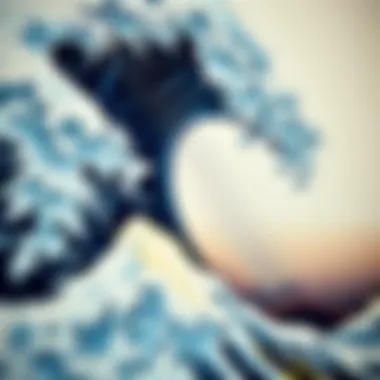
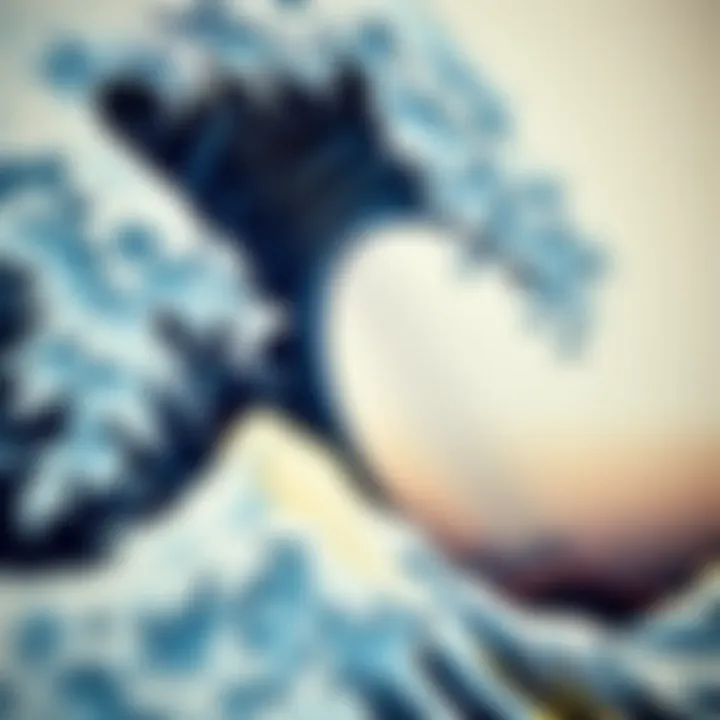
Edo Period: Cultural Significance
The Edo period, spanning from 1603 to 1868, was a time of relative stability and isolation for Japan. During this era, the country's economic growth fostered a vibrant urban culture, particularly in cities like Edo (modern-day Tokyo). This environment cultivated a love for art and literature among the growing merchant class. Ukiyo-e, the style of woodblock printing to which Hokusai contributed, flourished. It offered a glimpse into the life, beauty, and challenges of this era, resonating with people from various walks of life.
In this context, The Great Wave Off Kanagawa embodies the struggles faced by fishermen who battled the might of nature for their livelihoods. At the same time, it reflects the mingling of traditional Japanese art and Western influences that began to trickle in during this time. Hokusai's mastery of perspective and composition illustrated not just the physical strength required to navigate such tumultuous waves but also the deeper appreciation for nature that characterized the Edo period.
The Printing Process: Ukiyo-e Techniques
The making of The Great Wave involved meticulous techniques that form the backbone of Ukiyo-e art. This traditional Japanese method utilizes multiple blocks to create color prints. Hokusai employed a technique called benizuri-e for the red and blue hues seen in the waves and sky, ensuring vibrancy that has stood the test of time.
Interestingly, the process requires collaboration between artists, carvers, and printers. Each adds a unique layer to the artwork, much like how individual surfers contribute to the culture of surfing—each with their own story to tell. The precision required is staggering; three main color blocks were carved to produce the waves, and each must align perfectly to create the dynamic movement captured in the piece.
So, while modern technology has shifted the way we create and share art, the historical importance of Hokusai's methods speaks to the craftsmanship and artistry that goes into creating a legacy.
Art, history, and the environment converge in The Great Wave Off Kanagawa, offering insights that enrich both our understanding of the past and our perspectives on present-day cultural nuances. Through Hokusai's eyes, we see not merely waves but an enduring emblem of humanity’s relationship with nature.
"The majesty of nature can inspire fear and awe, leading one to respect it, as much as one might respect the waves." - Anonymous
Artistic Elements of The Great Wave
When you start to peel back the layers of The Great Wave Off Kanagawa, the first thing that strikes you is how intricate the artistic elements are. Hokusai didn't just throw paint on a canvas; he engineered a visual symphony that plays on the themes of nature, movement, and the human experience. These components don't just embellish the artwork—they lay the groundwork for its iconic status in both art and surfing culture. Emphasizing these artistic traits provides a deeper insight into why this piece bridges cultures and epochs.
Composition and Structure
The composition of The Great Wave is meticulously crafted. Hokusai employs a dynamic arrangement whereby the towering wave occupies the foreground, dwarfing the small boats and fishermen beneath it. This not only highlights nature's overwhelming power but also captures an exhilarating moment suspended in time. The way the wave curls, reminiscent of a hand reaching out, invites the viewer into its grasp.
Hokusai's choice of balance is critical here as well; Mount Fuji stands majestically in the background, acting as a steady contrast to the volatile wave. This juxtaposition of stability and chaos is compelling. One might argue that it's more than mere aesthetics—it's a metaphor for life's unpredictability. While one can strive for stability, nature often reminds us of its dominance.
The triangular composition formed by the wave and the mountain guides the viewer's eye. Such a geometric approach helps in establishing a rhythm, pulling the viewer into the heart of the piece, much like a surfer riding the crest of that very wave.
Color Palette and Symbolism
Color serves as a powerful language in this work, and Hokusai’s palette is not merely pleasing to the eye; it’s rich with meaning. The vibrant blues denote the ocean, evoking feelings of both majesty and menace. The use of gradients—from deep navy to striking turquoise—captures movement, imitating the shifting waters.
Strikingly, Hokusai utilizes the color white in the foam of the wave, symbolizing both purity and danger. This duality can also reflect the experience of surfing: exhilarating yet fraught with peril.
"Art is a reflection of life, and Hokusai's colors metaphorically portray the duality of our existence, where beauty often accompanies risk."
Hokusai’s deliberate choice of colors thus enhances the theme of conflict between human beings and nature. It captivates the viewer, ensuring that this piece resonates deeply with each observer. As surfers gaze upon the waves, they encounter not only a visual feast but also a reminder of their own struggles against nature.
Influence of Nature on Art
Nature significantly inspired Hokusai’s art, embodying an unspoken dialogue between the artist and the physical world. The waves he depicted are not merely for show; rather, they also resemble the tumultuous seas that surfers now grapple with.
By incorporating elements from his surroundings, Hokusai created art that transcends time. He not only captured the energy of the ocean but also encapsulated the very essence of nature’s spirit. This connection is vital for those who find solace in the act of riding waves, fueling a sense of belonging and understanding.
Hokusai’s artwork can be likened to the ocean’s waves: each crest and trough tells a story. This synergy of nature and artistry continues to influence modern surfers, who see The Great Wave not just as a piece of art but also as a cultural touchstone that speaks to their own experiences in the water. Through this lens, Hokusai’s work becomes an enduring exploration of what it means to engage with the natural world, a theme that continues to resonate with audiences today.
Iconography and Symbolism
The iconography and symbolism of The Great Wave Off Kanagawa opens the door to deeper understanding not just of the artwork itself but of its place within culture. This particular piece encapsulates how imagery can convey complex themes such as struggle, permanence, and the inherent power of nature. By dissecting these elements, we gain insights into both the artistic intent of Katsushika Hokusai and the broader cultural implications of his work in surfing culture and beyond.
Waves as a Cultural Motif
Waves have long served as a powerful motif across various cultures. In The Great Wave Off Kanagawa, Hokusai vividly represents waves, which can be interpreted in multiple ways. First and foremost, they symbolize the relentless force of nature—vast, dangerous, yet incredibly beautiful. This duality resonates in surfing culture, where surfers face the natural elements, seeking thrills and connection with the ocean.


Moreover, the waves in this piece evoke a sense of movement and fluidity. The curves mimic the ebb and flow of the tides, creating a rhythm that speaks to anyone familiar with the ocean's pulse. Surfers often relate to this; they ride the crest of a wave, experiencing that moment of exhilaration before plunging down into the ocean’s embrace.
- Cultural Resonance: Waves are often associated with resilience, reflecting human struggles against nature.
- Surfer's Connection: The wave experience for surfers mirrors that of the fishermen depicted in the artwork, capturing the thrill and danger that accompany pursuit of their passion.
Mount Fuji: An Element of Stability
In stark contrast to the tumultuous waves, Mount Fuji stands resolute in the background, embodying stability and permanence. Hokusai’s choice to include this sacred mountain heightens the narrative of the print. While the wave churns with chaos, Fuji remains unmoved—offering a stark reminder of endurance in a world constantly buffeted by change. For many, Mount Fuji symbolizes a cultural anchor, representing the ideals of Japan’s natural beauty and spirituality.
This contrast also subtly implies the balance between nature's ferocity and its calm. In essence, the mountain serves as a metaphor for seeking consistency amid the tempests of life. The duality plays into broader themes prevalent in surf culture, where surfers must respect the ocean's power while also relying on their skills and instincts to navigate it safely.
"The intersection of chaos and serenity is what draws us to the sea," says oceanographer Dr. Kenji Matsumoto.
The Fishermen: Echoes of Struggle
The fishermen depicted within the waves serve as poignant reminders of human struggle and resilience. Their small, fragile boats contrast starkly against the looming wave, representing the vulnerability of humanity against nature's vastness. This image reflects a universal narrative: the struggle between man and nature, a theme deeply embedded in many surf stories.
In surf culture, practitioners often view themselves as modern-day fishermen. Just as those in Hokusai’s print face the wave’s uncertainties, surfers also grapple with the challenges of ocean swells, tides, and weather conditions. The fishermen's plight mirrors the thrill—and sometimes, the peril—that comes with riding waves, emphasizing the respect that is needed when pursuing one's passion.
- Struggle and Triumph: The artwork encapsulates the idea that within each wave lies the potential for both disaster and exhilaration.
- Cultural Lessons: These fishermen remind us of the age-old relationship between humans and the sea, a relationship characterized by respect and, at times, rivalry.
This intricate narrative weaves together the elements of waves as cultural motifs, Mount Fuji's stability, and the fishermen's struggles. This rich tapestry reflects not only Hokusai’s artistry but also a shared cultural experience that resonates with surfers and art enthusiasts alike.
The Great Wave in Modern Culture
In the realm of art and culture, The Great Wave Off Kanagawa stands as a monument that transcends its original time and space. It's not just a part of Japanese artistry; it has woven itself into the very fabric of modern life, particularly surf culture. The wave has turned into a symbol, a sign of moments spent riding the tides and a reminder of the sea's formidable power. Its influence is felt today as it impacts various sectors—surfing aesthetics, fashion, contemporary art, and environmental conversations. Here we delve into specific elements that illustrate the cultural significance of this iconic artwork.
Influence on Surfing Aesthetics
The visual language of The Great Wave resonates deeply with surfing enthusiasts who embrace the ocean’s beauty and chaos. The artwork encapsulates the thrill of riding waves, echoing the emotions that surfers experience. This piece has shaped not just the visual elements but also the philosophy behind surfing.
- Visual Identity: The image connects surfers to their environment, portraying the exhilarating dance between man and nature. Designs that draw inspiration from Hokusai’s waves reflect the energy surfers feel during those moments of adrenaline.
- Cultural Symbolism: Much beyond mere decoration, the wave has established itself as a recognizable emblem in surf culture. Elements from the print appear in branding and merchandise, conveying a sense of identity that many surfers hold dear. It is a reminder of the spirit of adventure and challenges faced in the sport.
The representation of waves in art stimulates a deeper appreciation for the ocean, inspiring surfers to respect the very nature they commune with. In channels like social media, you'll see this artwork revisited frequently, shared by athletes and surf brands alike, thereby enhancing its visibility and relevance.
Adaptations in Fashion and Design
From streetwear to high fashion, the allure of The Great Wave has crept into various arenas of clothing and décor, transforming the print into a fashionable motif. Designers recognize its captivating aesthetic and the narratives it conjures. The adaptations often reflect a desire to bridge fashion with a deep connection to nature.
- Streetwear: T-shirts, hoodies, and accessories featuring the wave have gained popularity not just among surfers but also within everyday culture. This signifies a blend of art and lifestyle, making the iconic image accessible to a broader audience.
- Interior Design: Elements of the artwork appear in home décor, such as wallpapers and art prints, appealing to those who want to infuse inspiration into their living spaces. The wave, enclosed in stylish frames, brings the ocean’s energy into homes, serving as conversation starters and artistic focal points.
Fashion labels tap into this iconic imagery to convey a sense of freedom, adventure, and connection with nature. As trends evolve, the aesthetic remains continuously relevant, showcasing the artwork’s legacy.
The Wave in Contemporary Art
Contemporary artists are inspired by The Great Wave, leading to reinterpretations that span various forms and styles. This reimagining is not merely derivative; it signifies Hokusai's impact on modern artistry.
“The Great Wave transcends its frame to inspire countless artworks, serving as a bridge between tradition and modernity.”
- Innovative Techniques: Artists take liberties in their mediums. For instance, digital art has allowed reinterpretation of the wave, where visual effects mimic kinetic energy. This new age representation serves to jolt adrenaline into the viewing experience, capturing the pulse of surf culture today.
- Social Commentary: Several artists have used Hokusai’s waves to reflect on environmental issues facing the planet. By merging the beauty of this artwork with messages about climate change and sustainability, they create a powerful dialogue about nature and human impact.
Therefore, the spirit of The Great Wave Off Kanagawa thrives in contemporary art, upholding its relevance while sparking conversations that resonate far beyond the boundaries of its origin. It stays alive in the hearts of viewers and creators, an echo from the past that rings true into the present and beyond.
Environmental Reflections of The Great Wave
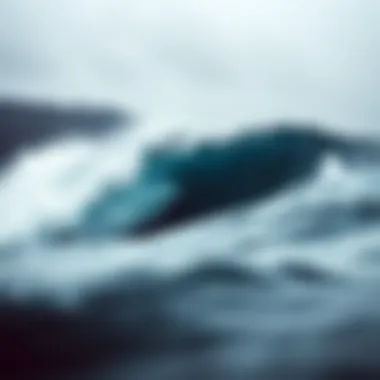
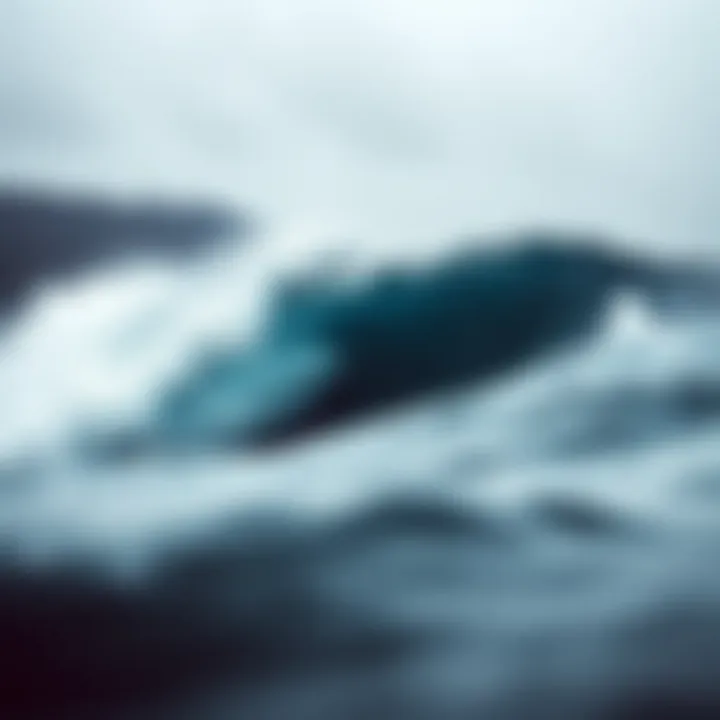
The intricate relationship between art and the environment is vividly depicted in The Great Wave Off Kanagawa. This artwork goes beyond stunning visuals; it serves as a poignant reminder of nature's might and fragility. In this section, we will delve into various elements of environmental reflections illustrated in this iconic print, examining its relevance to contemporary issues surrounding climate and culture.
Nature's Power: Waves and Climate
Waves symbolize the raw power of nature, reminding viewers of both its beauty and peril. Hokusai’s depiction of the towering wave captures a moment of tension, an unsettling balance between calmness and chaos. This juxtaposition reflects broader climatic issues faced by coastal communities today.
The ocean's surging waves are a direct consequence of environmental changes, often linked to climate fluctuations. Increased storm intensity and rising sea levels are not just statistics; they affect real people's lives. Recognizing waves as a force of nature compels society to reckon with the implications of climate change and its effect on coastal ecosystems.
Raising awareness about this planet's state through art is crucial. Artistic representations inspire discussions and can question our relationship with nature. Just as Hokusai's wave has swept into popular culture, it reminds us of the ongoing struggles against natural disasters, inviting us to reflect on our role in environmental stewardship.
Surf Culture and Environmental Responsibility
Surfing and environmental consciousness go hand-in-hand for many enthusiasts. The love for waves naturally nurtures a sensitivity towards their well-being. Surfers have a unique connection with the ocean; they feel its rhythms, understand its temperament, and witness firsthand the impacts of pollution and climate change.
In recent years, there’s been a paradigm shift in how surf culture views environmental responsibility. Initiatives like beach clean-ups and advocacy for sustainable practices have gained traction among surf communities worldwide. As they ride the waves, surfers also take a stand, pushing for clean oceans and healthy marine life.
For instance, organizations like Surfrider Foundation work tirelessly to protect coastlines and marine environments. By leveraging community activism, they embody the spirit of Hokusai's wave—an unstoppable force demanding respect and care. The merging of surfing with environmental advocacy reminds us that art can inspire tangible change, making discussions of conservation an integral part of surf culture.
Art as a Medium for Environmental Awareness
Art serves as a powerful conduit for expressing environmental narratives. In the context of The Great Wave, Hokusai’s art beckons viewers to engage with pressing topics. It does not merely depict a wave; it invites viewers to question their interaction with nature.
Through various forms—like installations, murals, and community art projects—creative expressions resonate with audiences, sparking dialogue and reflection about environmental issues. Artists today draw parallels between Hokusai's imagery and current climate crises, often integrating messages that reflect the urgency for action.
"Art holds a mirror to society; it reflects not only beauty but also societal woes, invoking change in the heart of its beholders."
Artworks that echo the themes of The Great Wave highlight the significance of harmonious coexistence with nature. The modern artist’s brush, inspired by Hokusai's legacy, wields the dual power of aesthetics and advocacy, using visual narratives to promote awareness and environmental responsibility. These reflections translate into action, urging us to consider the sustainable paths we must pursue.
As surfers and lovers of the sea engage with their environment, the legacy of The Great Wave Off Kanagawa reminds us of the responsibilities that come with appreciation for nature, intertwining our cultural narratives with the urgency of environmental care.
Relevant Links
- Surfrider Foundation
- United Nations Environment Programme
- Wikipedia - The Great Wave
- Britannica - Ukiyo-e
The Legacy of The Great Wave
The cultural footprint of The Great Wave Off Kanagawa is massive, echoing through time and transcending borders. It serves as a bridge, connecting the rich history of Japanese art with the vibrancy of modern-day surfing culture. As we dissect its legacy, it’s clear that this artwork is more than just a piece of art; it has become a global icon that continues to inspire generations.
Cultural Exchange Through Art
The Great Wave is a prime example of how art facilitates cultural exchanges. This print has been embraced worldwide, symbolizing not only the beauty of Japanese aesthetics but also the spirit of adventure associated with surfing. Across oceans and continents, you can find its image on everything from skateboard decks to fashion items.
- Influence on various cultures: Many artists have drawn inspiration from Hokusai’s work, adapting its motifs to local contexts.
- Fusion with local art: Hokusai’s wave has been reinterpreted in creative forms by indigenous artists in Hawaii, California, and beyond, intertwining local narratives of surfing and culture.
The blending of cultural elements inspired by this artwork enhances the appreciation of diverse perspectives, nurturing a global community united by shared passions.
Educational Impact on Surfing Community
Surfers often regard The Great Wave not just as art, but as a source of motivation and demonstrating the ethos of surfing. This iconic image plays a significant role in educational frameworks within the surfing community:
- Workshops and History Classes: Surf schools and cultural workshops utilize the artwork to teach about the relationship between art, nature, and sport.
- Awareness Campaigns: Discussions surrounding environmental issues are often framed around the Great Wave, emphasizing the need to respect and preserve the oceans surfers love.
- Interdisciplinary Learning: The infusion of art history with marine conservation efforts fosters a unique educational approach, combining aesthetics with the realities of protecting our environment.
By educating new generations about this piece, the surfing community cultivates a sense of responsibility, urging them to appreciate both the ocean and the cultural stories that surround it.
The Great Wave as a Timeless Icon
The Great Wave continues to captivate audiences today, embodying the connection between nature and human experience. Its ability to remain relevant is astonishing, marking it as a timeless icon:
- Universal Themes: Themes of struggle and triumph found in the print resonate with individuals from all walks of life, regardless of where they are.
- Art Beyond Boundaries: This piece is not limited to a specific genre. Its impact stretches across galleries, surfing brands, and everyday life, proving that art knows no boundaries.
- Modern Representations: Contemporary art movements often pay homage to Hokusai’s print, creating dialogues about nature, resilience, and creativity.
The legacy of The Great Wave Off Kanagawa endures not only because of its historical context but also due to its profound ability to inspire conversations on culture, struggle, and environmental awareness. As waves continue to crash against the shores, this artwork remains a powerful testament to the dynamic interplay between human expression and nature's mighty forces.















